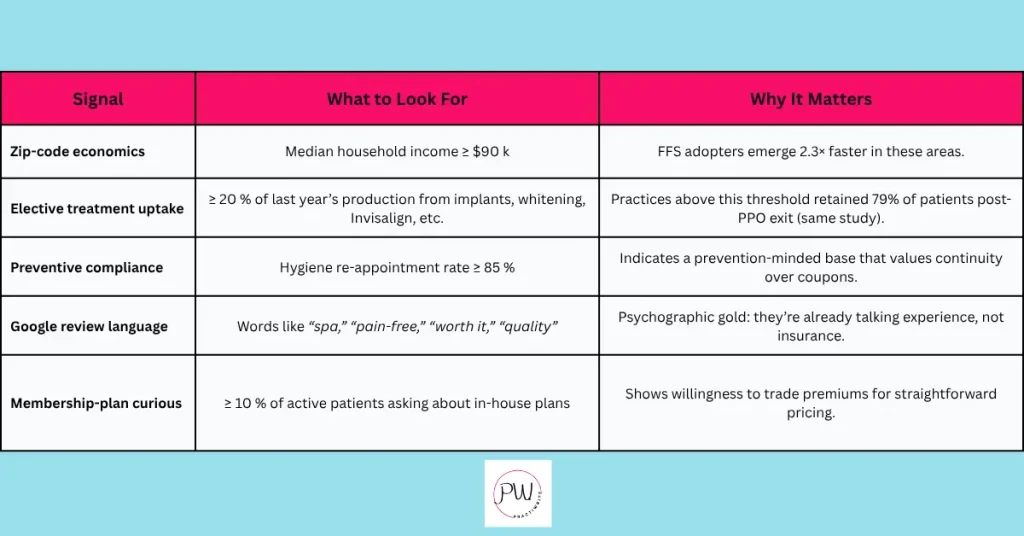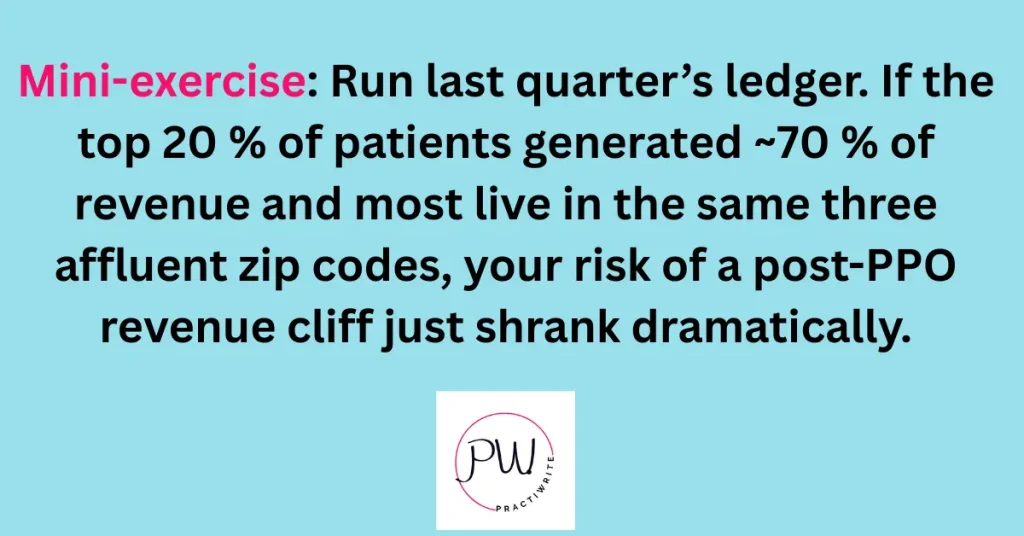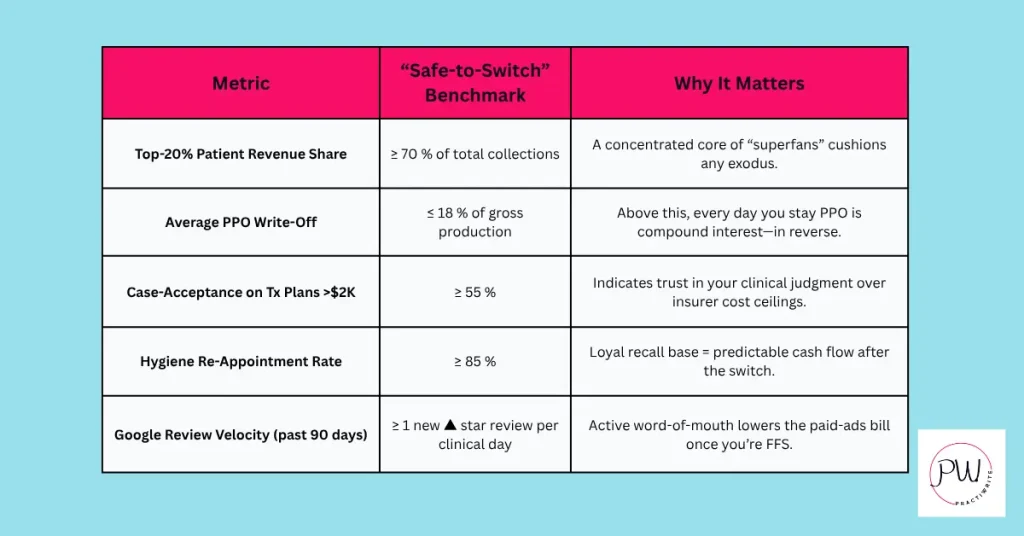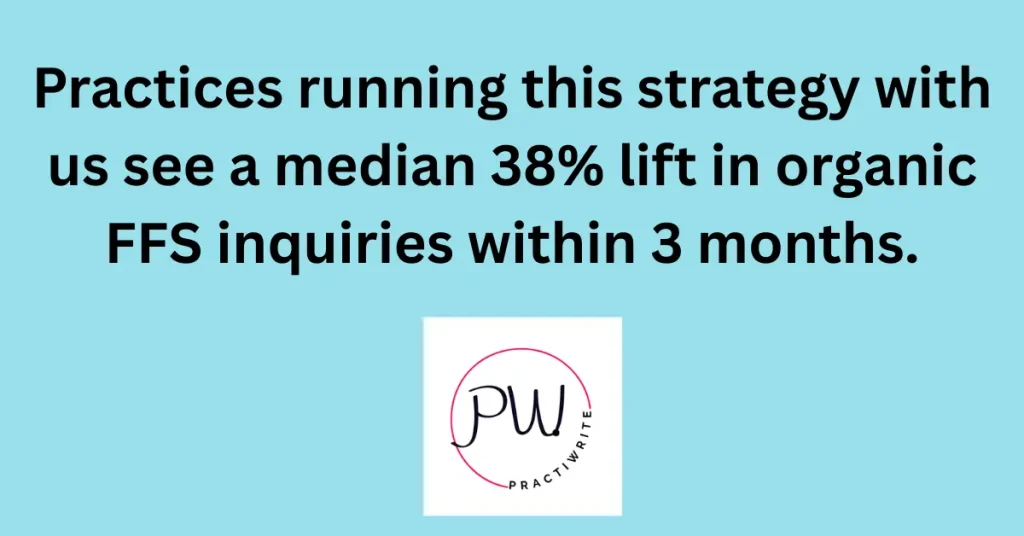Imagine this: It’s closing time.
The fluorescent hum settles into silence, your last hygiene patient has floated out the door with a complimentary lip balm, and the sterilizer’s green light flickers like a stubborn question mark.
On your desk sits a fat stack of EOBs—each one a polite reminder that you delivered $1,800 in care and collected $984.
You flip the final page, and an idea you’ve been secret-keeping all year refuses to stay quiet: What if I stopped letting PPO contracts score front-row seats to my production?
The thought is equal parts electric and terrifying.
Electric, because you know dentistry looks different when the only handshake is between you and the patient.
Terrifying, because everyone in your study club swears you’ll hemorrhage patients if you try.
You refresh your email, half-expecting a cosmic sign. Nothing, except a new-patient inquiry that asks the dreaded seven-word combo: “Do you take my insurance, doctor?”
Is your patient base ready for a fee-for-service model? Let’s answer that question—minus the industry clichés, minus the fear-fog.
By the time you scroll past the final period, you’ll have a litmus test mapped to your numbers, your community, and your growth goals.
No guesswork, no gut-feel gambling.
Crystal-clear readiness.
Ready to see whether your patient base is primed for a fee-for-service future—or whether you need a few strategic pivots first? Buckle in.
Your personalized clarity check is about to begin.
Table of Contents
The Mindset Gap: PPO Passengers vs. FFS Co-Pilots
Picture two patients in your chair.
Patient A keeps one eye on the ceiling TV and the other on her insurance card—she’ll green-light a crown only if the PPO fee schedule gives its blessing.
Patient B asks how long an E.max onlay will last and whether you’d mind taking an extra scan for her bite guard—she’s buying an outcome, not a discount.
A nationwide ADA Health Policy Institute pulse survey (Q4 2024) found that 61 % of adults would stay with a beloved dentist even if “out of network,” provided the experience and results felt superior.
Another 24 % said “maybe—convince me.” That leaves just 15 % who will bolt the minute you drop their PPO.
What does all this mean? The majority of departures you fear are negotiating space, not foregone conclusions.
Key takeaway: You don’t need every patient to cross the bridge. Just enough “co-pilots” who already value you more than their deductible.
Demographic & Psychographic Signals You’re Sitting on a Gold Mine
Think of readiness as a Venn diagram where capacity to pay overlaps with desire for premium care:

A 2024 McKinsey household-spend analysis reports that Gen X + older Millennials (now 40-55 years old) control 55 % of U.S. discretionary healthcare dollars and are “decisively brand-loyal when expertise is obvious.” If those cohorts dominate your schedule, you’re halfway home.

Patient readiness isn’t a hunch; it’s a mosaic of mindset, money, and motivation. Nail those three, and your “What if they leave?” nightmare morphs into “How soon can we upgrade the pano?” reality.
Up next—we’ll plug real numbers into a readiness calculator and show you exactly how steep (or gentle) your transition slope will be.
Data-Driven Readiness Assessment
Here’s some KPI Snapshot numbers you should pull tonight:

A 2024 Levin Group survey of 217 recent FFS converts found practices hitting 4 of the 5 benchmarks lost ≤ 11% of active patients in Year 1—vs. 27% attrition when only 2 benchmarks were met.
Road-Test It: The 60-Second Transition Calculator (Sneak Peek)
Grab three numbers off your practice-management dashboard:
- Average monthly collections (last 12 months) – call it $175K
- Total annual PPO write-offs – e.g., $310K
- Projected patient retention post-switch – start conservative at 70%
Plug & play formula:
New-Model Year-1 Revenue = (Monthly Collections × 12 × Retention Rate) + (Annual PPO Write-Offs × Recovery Factor)
Recovery Factor reflects fees you’ll actually collect once you’re free of PPO caps—industry median = 0.40 in Year 1, climbing to 0.70 by Year 3.*
Example:
(175K × 12 × 0.70) + (310K × 0.40) = $1.47M
Your headline: $1.47M vs. $2.10M today—a napkin drop of ~30 %. Now layer in:
- Membership-plan lift: +8 % (ADA Membership Economics Report, 2023)
- Marketing ramp: +6% (avg. FFS acquisition via Blended search/Paid ads blend)
- Fee increase on premium procedures: +4–12 % depending on case mix
Most practices claw back to parity by month 14–18—provided they were already brushing up against those KPI benchmarks.
Pro Tip: Not loving your calculator outcome? Tweak the dials—bump hygiene recall to 90%, test a 75% retention scenario, or model an extra implant case per week. Small gains compound faster once PPO ceilings vanish.
How To Turn “Insurance Shoppers” Into Fee-For-Service Loyalists
You have the numbers. Now you need to figure out how in the world you are gonna get more patients into your chairs.
All you need to do is smart marketing in the places where the patients you want to serve (not the budget shoppers) are located. Here’s how:
Local Search Domination: Maps Pack Leads Your Front Line
If you want patients who aren’t shopping by insurance card, you need to meet them exactly where they search: inside Google’s Local 3-Pack. This top-tier real estate pulls in 72% of local dental clicks.
And most patients never scroll past it.
Google doesn’t put “just anyone” in the Maps Pack. It promotes practices with fully optimized Google Business Profiles (GBP), consistent online presence, and regular activity.
What you can do today:
- Claim and verify your GBP at google.com/business.
- Ensure NAP consistency (Name, Address, Phone Number) across every directory—Yelp, Healthgrades, ZocDoc, and more.
- Upload geo-tagged photos weekly, including your operatory, front desk, and smiling team members.
- Post weekly updates using GBP’s “What’s New” feature. Think quick tips, service spotlights, or case-study highlights.
- Seed the Q&A section with helpful, insurance-free patient questions and answers (e.g., “Do you offer payment plans for cosmetic procedures?”).
Our agency builds on this with a Three-Tier Citation Sprint, schema markup, review optimization, and GBP content calendar—all designed to rank your practice in the Maps Pack for high-value searches like “implant dentist near me” and “IV sedation for dental anxiety.” For a deeper dive, check out this full GBP optimization guide.
Fully optimized GBPs are 2.7x more likely to appear in the Local Pack and receive 70% more direct calls than unoptimized profiles.
Content That Converts: Authority Wins Over Price
Patients who choose fee-for-service dentists aren’t looking for the cheapest provider. They’re searching for expertise, experience, and exceptional care.
The best way to demonstrate all three? Long-form, educational content that answers their questions before they call.
Our team specializes in building a strategic content engine designed to attract intent-driven searchers—patients ready to invest in better dentistry.
What you can do today:
- Start a blog on your practice website—use WordPress or a platform that supports structured data.
- Write articles for key FFS keywords, such as:
- “Is Invisalign worth it without insurance?”
- “What does a zirconia implant cost in [Your City]?”
- “How to find a holistic dentist without a PPO plan”
- “Is Invisalign worth it without insurance?”
- Use FAQ schema to mark up every blog post with patient-focused questions Google can display in search results.
- Link each post to your services pages to drive deeper engagement and SEO authority.
We take this further by planning monthly content calendars, writing SEO-optimized articles (just like this one), and formatting them to rank quickly and naturally. All content is backed by real keyword research, structured data, and conversion-focused CTAs that direct readers to book your FFS consult.

PPC + Meta Ads: Paid Traffic That Filters Out Price-Shoppers
Paid ads are only effective if they attract the right patients—people who value care, not coverage. We use Google Ads and Meta Ads (Facebook + Instagram) to laser-target your ideal patient segments with offers that speak their language.
What you can do today:
- Set up Google Ads campaigns with exact-match, high-value keywords:
- “Zirconia crown dentist [City]”
- “Emergency dentist no insurance”
- “Zirconia crown dentist [City]”
- Avoid broad match phrases like “dentist near me” which often attract price-sensitive PPO patients.
- Create Meta Ads with testimonial videos, before/after case images, or comfort-focused messaging like “Afraid of the dentist? We specialize in sedation care.”
- Retarget website visitors on Meta with service-specific follow-up ads—these warm leads convert up to 3x better.
Inside our dental marketing system, we manage these campaigns end-to-end. Our team monitors keyword costs, adjusts bids based on appointment quality, and integrates Instant Form ads with your CRM—so leads land right in your schedule without extra admin.
Meta Ads targeting 35–64-year-olds with testimonial creatives result in 35% lower CPL and higher treatment acceptance for FFS offers.
Review Velocity & Social Proof: Turn Happy Patients into Your Sales Team
You can tell patients you’re worth it—or let other patients do it for you.
Online reviews are the #1 trust factor for out-of-network patients. But it’s not just about your average star rating—it’s about volume, recency, and emotional tone.
What you can do today:
- Request reviews right after each visit, especially for cosmetic or comfort-focused procedures.
- Use SMS or email to send a direct Google review link.
- Respond publicly to every review—especially negative ones. Patients judge your tone more than the score.
We strongly recommend using a system which automatically requests feedback, filters unhappy patients to a private form, and pushes 4–5 star reviewers to your Google page. Our clients who use this system typically boost their total reviews by 58% in 90 days and raise their local search visibility significantly.
More reviews = better Maps rankings + higher patient trust = more FFS consults booked without insurance chatter.
Know What’s Working: Transparent Tracking from Click to Chair
Fee-for-service success depends on data. You don’t have time to guess which channels are working—you need to know.
With our integrated analytics dashboard, we connect your website traffic, ad performance, and scheduling software so you can track exactly:
- How many calls came from Meta
- Which keywords booked the most FFS consults
- What your true cost-per-booked-appointment is—by day, week, and month
You’ll have full transparency, and we pivot quickly. If a campaign doesn’t meet a 4× return in treatment value, we adjust or pause—fast.
Your Next Step: See the FFS Forecast for Your Zip Code
We don’t do guesswork. Our Dental Practice Roadmap™ Strategy Session gives you a crystal-clear forecast—how much traffic you’re getting now, how much you should be getting, and what our services will do to bring that result to you.
Staff Training & Communication: Your Secret Weapon for Patient Loyalty
A beautifully optimized website and a full schedule mean nothing if your front desk says, “We don’t take your insurance,” with a wince. In an FFS practice, your team isn’t just support.
They’re sales, retention, and reputation rolled into one.
Patients make emotional decisions about care based on the confidence, clarity, and tone of your team, especially when money enters the chat. If your staff isn’t fully aligned on the value of the transition, they’ll unconsciously transmit anxiety to patients.
The practices that thrive post-PPO aren’t just clinically excellent. They train their teams like elite concierge staff. Because that’s exactly what fee-for-service patients expect.
What Your Team Needs to Know (and Say) to Keep Patients Confident
- Scripts That Emphasize Empowerment, Not Exclusion
Avoid:
❌ “We no longer take PPOs.”
Use:
✅ “We’ve moved away from insurance restrictions so we can provide more personalized care. You’re free to use your benefits, and we’ll help with all the paperwork—nothing changes in how we treat you.” - Training Around Financial Transparency
Every team member—from hygienists to treatment coordinators—should know how to confidently walk patients through:
- Pre-treatment estimates
- Financing options (e.g., Sunbit, CareCredit, your own in-house membership plan)
- Membership plans (if offered)
- How to self-submit insurance claims (if applicable)
- Pre-treatment estimates
- According to our own research, practices that provide financial training to all front-facing staff experience 19% higher case acceptance rates.
- Roleplaying Difficult Conversations
Regularly practice scripts and real-life objections as a team. Common scenarios to prep for:
- “Why don’t you take my insurance anymore?”
- “Can I still come here if I have Delta?”
- “Isn’t this going to be more expensive now?”
- “Why don’t you take my insurance anymore?”
- The goal isn’t just to overcome objections—it’s to create a confident, consistent patient experience where everyone on your team speaks the same reassuring language.
Upgrade the Experience, Not Just the Price Tag
In a PPO model, patients expect fast and functional. In an FFS model, they’re paying for exceptional.
Train your team to hit touchpoints that make a premium experience feel natural:
- Greet patients by name before they reach the front desk.
- Offer warm towels or a beverage on arrival.
- Send post-op check-in texts from the actual provider.
- Create comfort protocols for nervous patients (blankets, headphones, aromatherapy).
Even small touches can make a patient say, “Wow… no other office does this.” That kind of emotional impact creates loyalty far stronger than a $20 PPO co-pay.
How We Support You Behind the Scenes
Our transition support includes onboarding your team with communication templates, objection handling scripts, and concierge etiquette checklists. We also offer add-on coaching calls for front desk staff and treatment coordinators to role-play real conversations using your exact patient demographics and services.
FFS success starts at the front desk—and scales in the op.
Financial Safety Nets: How to Transition Without Sinking Cash Flow
Yes, your revenue will take a dip. But it shouldn’t be a free fall.
When you first cut ties with PPOs, there’s a chance your collections will take a hit.
Some patients may leave.
Some will hesitate.
And your billing cycles will likely shift as you stop waiting on insurance checks and start collecting directly.
But here’s the difference between practices that survive and practices that scale:
The ones that plan for the dip come out stronger and more profitable within 12–18 months.
The ones who wing it? They burn through savings and return to PPOs six months later with less control and a bruised brand.
Let’s talk strategy.
Step 1: Calculate Your “FFS Transition Cushion”
To weather the dip with confidence, you’ll need a financial buffer that can absorb 3–6 months of reduced revenue while you attract and retain your ideal patients.
What to do:
- Audit your overhead: List monthly fixed costs (payroll, rent, supplies, etc.).
- Multiply by 3–6x: This is your minimum cash cushion.
- Factor in marketing ramp-up costs: Ads, content, and local SEO optimization—typically $2–5k/month for a mid-sized office.
- Compare that to your retained revenue: Use your FFS Calculator (see earlier section) to estimate your revenue with a conservative 60–70% retention rate.
If your practice generates $150k/month and you’re anticipating a 30% drop, that’s a $45k monthly shortfall. Three months of cushion = $135k.
You don’t need that all in cash—but you do need access to it (LOC, credit, reserve savings, or a strategic partner).
Step 2: Introduce a Membership Plan to Stabilize Recurring Revenue
In-house membership plans give patients a way to stay—even if their insurance doesn’t.
According to Kleer’s 2024 Dental Economics Report, practices with active membership plans see:
- 2.5× more preventive visits per year
- 32% increase in per-patient annual value
- Higher retention from patients over age 50
What to offer:
- Annual or monthly fee (e.g., $399/year or $39/month)
- 2 cleanings, exams, and X-rays included
- 10–15% off additional treatments
- Exclusive perks (e.g., priority scheduling, free fluoride)
We help practices build their marketing strategies targeting the patients you want and need by using a blended search approach combined with Meta Ads.
Step 3: Offer Financing Without the Fear
Not everyone can afford a $2,400 implant out-of-pocket. But plenty of patients will accept it with a friendly payment plan—especially when it’s explained the right way.
Here’s how to implement flexible financing without sounding like a used car lot:
- Partner with trusted third-party lenders (e.g., Sunbit, Proceed Finance, CareCredit).
- Train your team to present 2–3 payment options before the patient asks.
- Highlight financing in your marketing: “Yes, we’re out-of-network—and yes, we make elite care affordable.”
We build financing scripts and visuals into your website, treatment plans, and ad funnels to normalize high-ticket cases—without sticker shock.
According to Proceed Finance, offering flexible payments increases case acceptance by 40% on treatment over $3,000.
Step 4: Create a 12-Month Cash Flow Forecast
Numbers don’t lie. And when you can see the peaks and dips, the process feels less like a leap of faith and more like a business strategy.
What to include in your forecast:
- Baseline monthly collections (historical avg.)
- Projected retention rate (start at 65–70%)
- Marketing expenses
- Payroll + overhead
- Anticipated membership revenue
- Financing utilization
This Dip Is Temporary, But the Upside Is Permanent
Most practices see a drop in production for 6–12 months. But when done right, that temporary dip leads to higher margins, less stress, and a more loyal patient base. And you’ll never again have to grind through four crowns in a morning just to break even.
Planning your transition like a CFO doesn’t mean you’re being too cautious—it means you’re building a practice that lasts.
Competitive Positioning: How to Stand Out in a PPO-Heavy Market
Patients don’t pay more unless you give them a reason.
There are 15 other dentists within a 5-mile radius of your office. Ten of them accept every PPO under the sun.
And four of them offer “$99 New Patient Specials” in bright red font.
In that sea of sameness, what makes someone choose you—especially when they’ll be paying more out-of-pocket?
The answer: strategic differentiation that hits at the emotional, clinical, and experiential level.
It’s not about being louder. It’s about being sharper, clearer, and more unforgettable.
Step 1: Define Your Flagship Differentiator
What’s the one thing your practice does better than anyone else nearby? If you don’t know—your patients don’t either.
Common FFS Differentiators:
- Same-day crowns with CEREC or Glidewell tech
- Advanced sedation options (IV or oral-conscious)
- Holistic or biologic dental focus
- Full-arch implant solutions
- TMJ, airway, or sleep dentistry
- Spa-like environment with aromatherapy, heated towels, and entertainment
What you can do today:
- Make a list of all services, technology, or amenities you offer.
- Highlight the ones your competitors don’t promote.
- Choose one core differentiator to lead with across your website, ads, and verbal scripts.
We help dentists identify and brand their unique differentiator as part of your Dental Practice SEO Sprints Service. It becomes the anchor for your content, your local SEO keywords, and your advertising language.
Clinics that lead with a clearly defined specialty or premium focus see up to a 23% higher conversion rates on consultation calls.
Step 2: Tell Stories That Justify the Premium
“High quality care” means nothing unless the patient feels it.
The fastest way to build value? Patient success stories—on your website, social media, and in your ops.
What you can do today:
- Create a library of before/after photos.
- Ask your happiest patients for 15-second testimonial videos (HIPAA-compliant, of course).
- Write mini case studies in your blog or email newsletter:
- “How Sarah overcame dental anxiety and replaced her smile with implants she paid for using our financing plan.”
- “Why Tom chose our office over in-network providers for his son’s airway treatment.”
- “How Sarah overcame dental anxiety and replaced her smile with implants she paid for using our financing plan.”
We turn these assets into compelling, conversion-optimized content that turns browsers into believers—and believers into booked patients.
Step 3: Partner Where PPO Offices Can’t Compete
Fee-for-service isn’t just a pricing model—it’s a positioning strategy. You have more flexibility than PPO-bound practices to build strategic alliances that elevate your brand.
Potential partnerships:
- Local boutique med spas or dermatology offices (cross-promote cosmetic services)
- Yoga studios or wellness centers (for biologic or holistic branding)
- Oral surgeons and sleep physicians (for comprehensive care handoffs)
What you can do today:
- Identify 3 local businesses with overlapping clientele.
- Offer to exchange referrals, email promos, or social posts.
- Invite them to an open house or patient appreciation event.
Step 4: Audit Your Brand Presentation—Does It Match Your Value?
If your website looks like a coupon flyer, your patients won’t believe you’re worth premium prices—no matter how skilled you are.
How to check your brand alignment:
- Look at your homepage. Does it feel elevated, warm, trustworthy?
- Are your photos stock images—or real patients and real smiles?
- Is your copy all about insurance… or all about outcomes and experience?
Your website messaging and visual design should position you as a premium, trustworthy brand—not a PPO mill.
Your Positioning = The Permission Patients Need to Say “Yes”
When you create a clear, confidence-inspiring reason for your patients to stay—and a story that aligns with their values—price becomes secondary. And PPO loyalty fades.
Fee-for-service success isn’t about convincing everyone.
It’s about magnetizing the right patients with the right message.
Your 10-Point Readiness Checklist: Is Your Patient Base Ready For A Fee-For-Service Model?
You’ve made it through the mindset shifts, the marketing must-haves, the financial planning, and the positioning strategy. But let’s boil it down:
Are you actually ready to make the jump?
Use this 10-point checklist to find out. If you check off 7 or more, you’re closer than you think.
✅ 1. At least 60–70% of your monthly revenue comes from your top 20% of patients
These are your loyalists—the ones who already choose you for trust, not convenience.
✅ 2. You’re writing off more than 15% of production to PPOs
That’s not “participating.” That’s subsidizing. And it’s eating your margins.
✅ 3. Your hygiene reappointment rate is 85% or higher
This shows patients are invested in prevention—not just showing up when insurance covers it.
✅ 4. You’re collecting at least one new Google review every week
Social proof signals are essential to attract new FFS patients online.
✅ 5. You’ve defined a clear, premium differentiator for your practice
You know exactly what sets you apart from the PPO crowd—and you lead with it.
✅ 6. You have a fully optimized Google Business Profile and appear in the Maps Pack
If you’re not ranking locally, you’re invisible to the 70% of searchers who never scroll.
✅ 7. You’ve mapped out a 3–6 month cash cushion or access to working capital
Going FFS without a financial buffer? That’s a gamble. But with a cushion? It’s a strategy.
✅ 8. Your front desk can confidently answer: “Why don’t you take my insurance?”
No awkward pauses. No confusion. Just clarity and confidence that builds trust.
✅ 9. You’ve launched or planned a membership plan for uninsured or out-of-network patients
A well-structured plan creates predictable revenue and a reason to stay for price-conscious patients.
✅ 10. You’ve scheduled (or are ready to schedule) a marketing strategy aligned with FFS goals
No more generic “we accept most insurances” messaging. Your content, ads, and SEO are focused on attracting the right patients, not just more of them.
Your Score:
- 8–10 checks? You’re ready—seriously. Let’s get this show on the road.
- 5–7 checks? You’re close. A little fine-tuning, and you can confidently start the process.
- Below 5? You’re not far off—but it’s time to fix a few foundation cracks before jumping in.
Some Final Thoughts: Ready to Know for Sure? Get Your Free Dental Practice Roadmap™
No two transitions look exactly the same—but your game plan should be personalized.
Our complimentary Dental Practice Roadmap™ Strategy Session walks you through:
- Patient retention forecasts based on your practice demographics
- Local search analysis to see if you can rank against PPO competitors
- Custom marketing strategy aligned with your fee schedule and case mix
It’s free. It’s tailored. And it’s the fastest way to find out whether your practice is truly ready to make the leap.
Book your free strategy session now and take the first step toward building the practice—and lifestyle—you’ve been working for.
10+ year content strategist, writer, author, and SEO consultant. I work exclusively with dental practices that want to grow and dominate their local areas.
